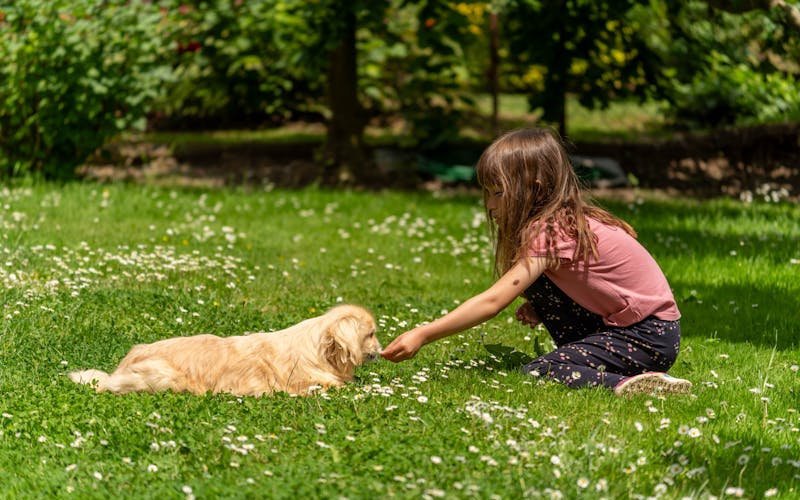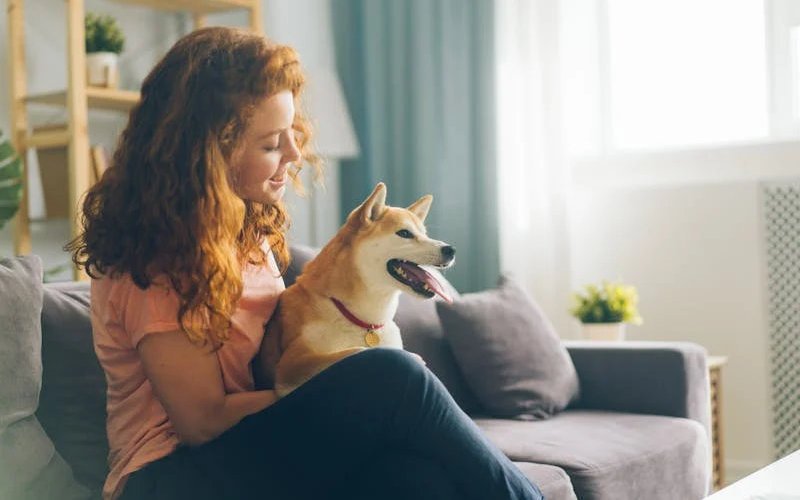For new dog owners, teaching your dog basic commands are invaluable for creating a well-behaved, happy pet. Training your dog in essential commands like “sit,” “stay,” and “come” not only strengthens your bond but also helps with safety and obedience in everyday situations. In this guide, we’ll walk you through the essential commands, effective training techniques, and tips on maintaining your dog’s skills over time, so you and your canine companion can enjoy a well-communicated, stress-free life together.
Table of Contents
Teaching Your Dog Basic Commands – Why is it Important?
Safety and Control in Any Situation
Basic commands like “sit,” “stay,” and “come” can be lifesavers in unpredictable situations, whether it’s stopping your dog from bolting across a busy street or calling them back when they’re approaching a dangerous area. For new dog owners, tips on reinforcing these commands daily will help ensure your dog responds reliably in emergencies.
Improved Behaviour and Discipline
Teaching basic commands helps prevent unwanted behaviours. Dogs who understand commands like “leave it” or “drop it” are less likely to grab or chew on household items or food they shouldn’t eat. By setting clear boundaries, new dog owners can create a calm, well-mannered pet who respects their space and responds to guidance.
Enhanced Socialisation and Confidence
When dogs understand basic commands, they’re generally more confident and well-behaved around other people and pets. Commands like “down” and “wait” allow you to manage your dog in social situations, making walks and playdates more enjoyable and less stressful. For new dog owner tips on socialising with confidence, basic commands are a strong foundation.
Mental and Physical Stimulation
Training is not only about discipline; it also provides mental stimulation. Teaching your dog commands and practising them regularly engages their brain and gives them a sense of purpose. Dogs need this stimulation as much as physical exercise to stay healthy and content.
Stronger Bond Between You and Your Dog
Lastly, teaching commands strengthens your relationship. Dogs thrive on structure and direction, and learning commands with you builds trust. For new dog owners, tips like spending dedicated time training each day not only teach your dog but also deepen your connection and mutual understanding.

Essential Commands Every Dog Should Know
Teaching your dog basic commands is one of the best things a new dog owner can do. These foundational commands make daily life easier and safer for both you and your dog. Here are the core commands every dog should learn, along with tips for each one:
Sit
“Sit” is often the first command new dog owners teach because it’s simple yet effective. A dog who sits on command is easier to manage in various situations, from greeting guests to waiting at a curb. To teach “sit,” hold a treat above your dog’s head and slowly move it back; as they follow the treat, they’ll naturally lower into a sitting position. Give the command “sit” and reward them as soon as they comply.
Stay
“Stay” is invaluable for keeping your dog in place when needed, whether it’s pausing on a walk or preventing them from rushing through a door. To teach this command, have your dog sit, then hold up your hand and say “stay.” Take a few steps back, and if they stay, reward them. Gradually increase the distance and duration. For new dog owners, tips like starting with short distances and practising regularly will improve your dog’s ability to stay put.
Come
The “come” command, also known as recall, is crucial for safety. It allows you to call your dog back if they’re off-lead or heading toward something dangerous. Start by calling your dog’s name, then say “come” in an upbeat tone. When they come to you, offer a treat and plenty of praise. Practising “come” indoors before trying it outdoors can help build a reliable recall for new dog owners.
Down
“Down” is a helpful command for keeping your dog calm in social situations, as it signals them to lie down and relax. To teach “down,” have your dog sit, then lower a treat to the floor. As they follow it, their body will naturally lie down. Once they’re in position, say “down” and reward them. Practising this command regularly can prevent jumping and make it easier to settle your dog when needed.
Leave It
“Leave it” teaches your dog to ignore items that could be harmful or off-limits, like dropped food or toys that aren’t theirs. To teach it, show your dog a treat in your hand, close your hand, and say “leave it.” When they back off, reward them with a different treat. Over time, you can introduce this command in real-life situations. For new dog owners, tips like using high-value rewards can make this command easier to master.
Step-by-Step Guide to Teaching Each Command
Training your dog can feel overwhelming, but breaking it down into simple steps makes the process manageable, especially for new dog owners. Here’s a step-by-step guide to teaching the most essential commands, with tips to make training easier and more effective.
How to Teach “Sit”
- Hold a Treat: Start with a treat your dog loves. Hold it slightly above their nose.
- Move the Treat Backwards: Slowly move the treat back over your dog’s head. As they look up to follow it, they’ll naturally sit down.
- Say “Sit”: As soon as your dog sits, say “sit” and give them the treat with praise.
- Repeat: Practise for a few minutes each day. Keep sessions short to hold your dog’s attention.
New dog owner tips: Use a cheerful tone, and avoid pushing your dog into a sitting position—let them do it themselves.
How to Teach “Stay”
- Start with “Sit”: Ask your dog to sit first, as “stay” is easier to teach from this position.
- Give the “Stay” Command: Hold your hand up like a stop sign and say “stay.”
- Take a Small Step Back: If your dog stays in position, return to them and reward with a treat.
- Increase the Distance Gradually: With time, take more steps back and ask them to “stay” for longer.
New dog owner tips: Practise in a distraction-free environment to build focus, then gradually add distractions as they improve.
How to Teach “Come”
- Use a Long Lead: If you’re outside, attach a long lead to keep control while your dog learns.
- Say Their Name, Then “Come”: Call your dog’s name in a cheerful voice, followed by “come.”
- Encourage with Treats or Praise: When they come to you, reward with a treat or lots of praise.
- Practise Regularly: Start in a safe area and gradually introduce distractions to strengthen their response.
New dog owner tips: Always reward your dog when they come, even if they’ve been distracted. You want them to see “come” as a positive command.
How to Teach “Down”
- Start from “Sit”: Ask your dog to sit.
- Hold a Treat at Floor Level: Move a treat down to the floor and away from their paws. As they follow, they should naturally lie down.
- Say “Down”: Once they’re lying down, say “down” and give the treat.
- Practise Regularly: Repeat daily to reinforce the command.
New dog owner tips: Use a calm, soothing voice for this command to help your dog stay relaxed.
How to Teach “Leave It”
- Show a Treat in Your Hand: Hold a treat in your closed hand and show it to your dog.
- Say “Leave It”: When your dog tries to get the treat, say “leave it.” Keep your hand closed.
- Reward for Ignoring: The moment they back away or stop trying, reward them with a different treat.
- Gradually Add Real-Life Practice: Practise around items they find interesting but shouldn’t touch.
New dog owner tips: Practise patience with this command—it can take a bit longer, but it’s highly useful.

Tools and Techniques to Help with Training
Training a dog is easier and more effective with the right tools and techniques, especially for new dog owners. Having a few essentials on hand can help your dog learn commands faster and make training more enjoyable. Here’s a guide to the tools and techniques that can make a big difference.
1. Treats
Using treats as rewards is one of the most popular training techniques. High-value treats—small, soft, and easy to chew—work best because they’re quick to eat and keep your dog engaged. Reward your dog as soon as they perform the command to reinforce the behaviour.
New dog owner tips: Keep a variety of treats on hand to keep your dog interested, but avoid overfeeding by using tiny pieces during training sessions.
2. Clicker
A clicker is a small device that makes a clicking sound when pressed. Clicker training involves pressing the clicker the moment your dog does the desired behaviour, followed by a treat. The click sound marks the behaviour precisely, which helps dogs learn faster.
New dog owner tips: Start by “charging” the clicker—click and give a treat a few times in a row until your dog associates the sound with a reward.
3. Training Lead
A long training lead (around 10-15 feet) gives your dog room to move while allowing you to maintain control. It’s particularly useful when teaching “come” or practising recall in an open space.
New dog owner tips: Use the lead in a safe, open area and practise commands in a distraction-free environment before gradually adding more distractions.
4. Harness
A well-fitted harness provides better control during training, especially for commands like “come” and “stay.” Unlike collars, a harness reduces strain on your dog’s neck, which can be especially beneficial if they’re prone to pulling.
New dog owner tips: Choose a harness that fits snugly but comfortably. It should be easy to put on and take off, and allow freedom of movement without chafing.
5. Consistent Commands and Hand Signals
Using consistent words and hand signals helps your dog understand what you’re asking. Dogs respond well to clear commands that don’t change. For example, always use “come” instead of switching between “come” and “here.”
New dog owner tips: Pair hand signals with commands to improve understanding, especially if your dog is easily distracted by sounds or if you’re in a noisy environment.
6. Positive Reinforcement
Positive reinforcement is a powerful technique that involves rewarding your dog for good behaviour rather than punishing unwanted behaviour. By focusing on rewards, you encourage your dog to repeat the behaviours you want.
New dog owner tips: Use rewards consistently but phase them out gradually, switching to verbal praise and petting to reinforce good behaviour over time.
7. Practise Sessions and Timing
Keeping training sessions short (5–10 minutes) and ending on a positive note helps keep your dog motivated. Dogs, especially puppies, have short attention spans, so regular but brief sessions are more effective than long ones.
New dog owner tips: Aim to train when your dog is alert but not overly excited or tired—ideally after a walk but before mealtime.
Maintaining and Reinforcing Commands Over Time
Once your dog has learned basic commands, it’s essential to reinforce and maintain them regularly. Consistency is key, especially as your dog ages or encounters new environments. Here are practical tips to help new dog owners keep commands strong and reliable over time.
Practise Commands in Different Settings
Dogs often learn commands in specific settings, like at home, but may struggle to follow them in busier or unfamiliar places. Practising commands in various environments, such as the park, in the car, or at a friend’s house, strengthens your dog’s understanding.
New dog owner tips: Start with low-distraction environments and gradually add distractions. Praise your dog when they respond correctly in new situations.
Integrate Commands into Daily Routine
Using commands throughout the day makes them second nature to your dog. For example, asking for a “sit” before meals, a “stay” at the door, or a “come” when calling them inside makes training a natural part of their routine.
New dog owner tips: Look for everyday opportunities to practise commands. Reinforcing them in routine activities keeps your dog’s skills sharp without needing dedicated training sessions.
Reward Consistently but Begin to Phase Out Treats
When your dog is learning a command, frequent rewards help reinforce the behaviour. However, once they’re reliable, you can start phasing out treats to avoid over-reliance. Gradually switch to verbal praise, petting, or the occasional treat.
New dog owner tips: Use a mix of rewards to keep things interesting and ensure your dog obeys commands without expecting a treat every time.
Refresh Commands Every So Often
Even well-trained dogs benefit from occasional training refreshers. Set aside time every few weeks to go over key commands, especially ones they don’t use often. This helps prevent “rusty” behaviour and keeps commands top of mind.
New dog owner tips: Make refreshers enjoyable by keeping them short and rewarding. This approach helps your dog maintain confidence and enthusiasm for training.
Stay Patient and Consistent
Dogs, like people, can have off days. If your dog struggles with a command one day, stay patient and avoid punishment. Instead, use positive reinforcement and consistent practice. Over time, their response will improve.
New dog owner tips: Remember that training is a lifelong process. A consistent, encouraging approach will strengthen your bond and improve your dog’s responsiveness.
Adapt Commands as Your Dog Ages
As dogs grow older, their hearing, vision, or mobility may change, affecting how they respond to commands. For instance, they may respond better to hand signals if hearing declines. Stay attentive to your dog’s needs and adapt as necessary to keep commands effective.
New dog owner tips: Being aware of changes in your dog’s behaviour or health can help you adjust training techniques and maintain good communication as they age.
Conclusion & Final Thoughts
Training your dog in basic commands is one of the best things a new dog owner can do to build a strong, healthy bond and ensure safety and good behaviour. From teaching “sit” and “stay” to maintaining these skills over time, each step helps you communicate clearly with your dog and enjoy life together to the fullest. Using the right tools, practising consistently, and reinforcing commands as part of daily routines can make training an enjoyable and rewarding experience for both of you.
With these new dog owner tips, you’re well-equipped to teach essential commands, keep them sharp, and adapt as your dog grows. Remember that patience, positive reinforcement, and consistency are key. A well-trained dog is a happier, more confident companion, and your commitment to training will strengthen the bond you share for years to come.




